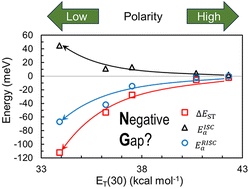Luminescence mechanism analysis of a TADF molecule showing peculiar thermal behavior
Abstract
In recent years, much attention has been paid to the development of thermally activated delayed fluorescence (TADF) materials with short delayed-fluorescence lifetimes to improve the device performances of OLEDs. In principle, by reducing the highest occupied molecular orbital (HOMO)–lowest unoccupied molecular orbital (LUMO) overlap, while the energy difference between S1–T1 (ΔEST) and activation energy (Ea) can be reduced, and the reverse intersystem crossing rate constant (kRISC) can be accelerated, a decrease in the radiative rate constant happens, necessitating an advanced molecular design. Furthermore, a molecule based on heptazine as a parent skeleton has recently been found to have a peculiar temperature dependence of luminescence decay, suggesting a negative gap (NG) material. In this report, we show that 9-[1,4]benzoxaborino[2,3,4-kl]phenoxaborine-7-yl-1,3,6,8-tetramethyl-9H-carbazole (TMCz-BO), a donor–acceptor linked TADF molecule with a very short delay lifetime of 750 ns, exhibits a peculiar thermal behavior similar to that of NG materials based on the temperature dependence of its luminescence decay in solution.

- This article is part of the themed collection: Challenges and prospects in organic photonics and electronics


 Please wait while we load your content...
Please wait while we load your content...